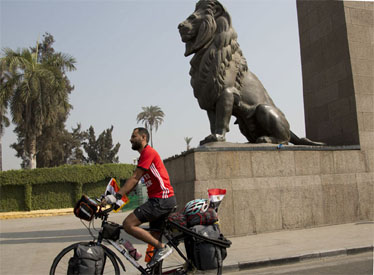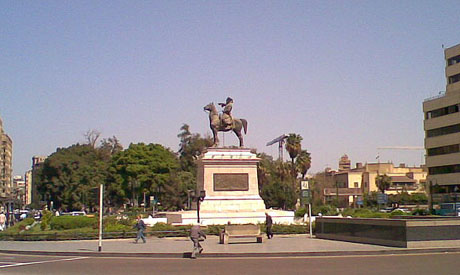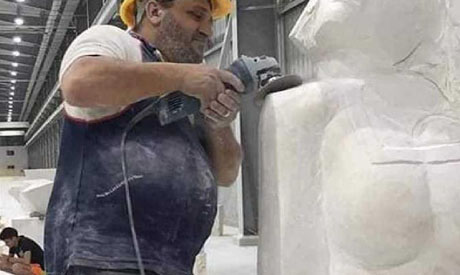Earlier this month, the images of a sculpture, Masr Tunhud (Egypt Rising) by artist Ahmed Abdel-Karim, provoked debate on the future of street sculpture in Egypt.
What fueled the debate is that Masr Tunhud echoes the famous Nahdet Masr (Egypt's Renaissance, also known as Egypt's Awakening) statue, Mahmoud Mokhtar's masterpiece dating from 1920.
Egypt's street art is a subject that resurfaces on many occasions. Traditional statues of great historical figures adorn public squares, and a number of contemporary works have been added to the city over time.
In Cairo only, one can notice that sculptures have become an integral part of public space. What would the Qasr Al-Nil Bridge in Downtown Cairo be without its four monumental bronze lions? Or Opera Square without the statue of Ibrahim Pasha (1789-1848), Khedive of Egypt and Sudan? Or Egypt's Renaissance adorning the famous square in Giza?
So many works enrich the urban landscape, seen by all locals, passers-by and travelers.
“Egyptian sculptural art has very deep roots. You have to be proud of it. But the artistic reality today testifies to a real crisis, being locked in the classical basis, far from the concepts of modern or postmodern art," comments Mohsen Ateya, a painter, art teacher and critic.
Ateya added that though the sculpture of Egypt Rising has been heavily criticised, it bears little resemblance to the artwork of Mokhtar.
"It is also necessary to be aware of the very different historical and societal contexts. In addition, it is impossible to enclose art in strict forms and perspectives. Picasso with Les Demoiselles d'Avignon (1907) paved the way for Cubism. It was rejected at the time, but is highly regarded today. I do not seek to defend the sculptor Ahmed Abdel-Karim. However, I find it unfair to judge his work in such an uncompromising manner, having as a reference the masterpiece of Mokhtar."

Mohammed Nufal, 24, rides his bicycle past the famed lion statues on Qasr El-Nile bridge in Cairo, Egypt, Saturday, April 7, 2018 (Photo: AP)
A communication tool
Renowned Egyptian painter and sculptor Mohamad Abla expresses a different viewpoint, dismissing Egypt Rising as "awful."
"The sculpture doesn't even deserve criticism! There are no more street sculptures today," he said.
According to Abla, 99 percent of street sculptures date from a period before the 1952 Revolution. “This culture is almost absent in our current society. However, this kind of sculpture must be part of the founding protocol of cities. Sculptures in public spaces are still to some extent an effective communication tool, reaching the entire population, including the less educated segment of society. They are an integral part of public space. They have both a public edification function and an urban planning function,” Abla emphasised.
He then elaborated on the concept of artists' contribution to the vitality of urban life, and how they can solicit it.
“It is not very clear. A plan of collaboration between artists and state institutions must be put in place so as to offer visual culture to the public. In addition, the state should not be the exclusive owner of everything related to public space. This, being rather a common property, should reflect a societal choice,” Abla said, pointing to how his sculpture Sisyphus was selected by three committees at the level of the state, the governorate and the community before being placed in one of the squares in the town of Walsrode, in northern Germany.
"Nothing should be left to chance. You have to start by launching competitions between artists. Then the public must take part in the selection,” he said.

Ibrahim Pasha statue at Opera square
Lack of visual culture
Sculptor Ahmed Karali has designed more than 30 sculptures, located now in several countries, including the United States and Russia.
"What are the places in Egypt suitable to have sculptures?" he asked, pointing to the fact that the problem is much bigger than just sculpture, and it extends to urban harmonisation.
He gave as an example an obelisk that was placed a few months ago in the centre of Tahrir Square and which Karali finds not suitable for this space.
"I really ask myself several questions: Who should protect the artist's work after his death? What is the role of the Fine Arts Syndicate? At the roots of this bizarre situation is poor management. We are venturing into areas we are not aware of," he said.
Karali added one more question, expressing himself with some bitterness: "What are we trying to achieve through the visual arts? How to establish an artistic theory like the German Bauhaus school which established a basis for reflection, linking art to architecture, to design ... and so on. We need real reform in this sector. We have seen that few people rose up against the demolition of the historic Mamluke cemetery, but many did not hesitate to fiercely criticise the sculpture of Ahmed Abdel-Karim, without taking into account that it is his first work and that he is originally a ceramic and installation artist."
Tarek Al-Koumi, sculptor of several works, including the statues of renowned singers Umm Kalthum and Mohammed Abdel-Wahab standing at the Cairo Opera House grounds, agrees with Karali.
“There is no crisis in street sculpture. It is illogical to condemn Egyptian sculptors for a lack of professionalism on the part of an artist who is making his first attempts with a sturdy material like marble. We have very beautiful sculptures like those of Ahmad Shawki made by Gamal Al-Seguini, of Al-Akkad by Abdel-Aziz Saab, of Taha Hussein by Abdel-Hadi Al-Weshahi and of Omar Makram by Mahmoud Fathi."
According to Al-Koumi, there is a state of anarchy in the streets. Billboards and different ads posters are placed haphazardly on bridges and streets to such an extent that public space has become invisible, and public art is blurred. The environment in which the sculptor works is very stressful: “We do not hesitate to pay a million Egyptian pounds to a singer for half an hour, and we refuse to pay such a sum to a sculptor who spends months to do a work that requires physical work, a suitable place, materials and much more."
The public and their way of perceiving works of art is also a problem. Passing next to a sculpture does not necessarily mean that the passer-by paid attention to it. As Al-Koumi notes, the public is poorly qualified to judge the work.
“Dedicated to famous people or reflecting national values, street sculptures have always had a symbolic significance and are linked to the notion of visual culture. Unfortunately, a minority has this culture. And it is obvious that in such an atmosphere it is ugliness that reigns. The state must support artists and find a way to instill in future generations the passion and ability to savour figurative or abstract art,” Al-Koumi concluded.

Ahmed Abdel Karim Abdel Naby working on Egypt Rising sculpture (Photo: artist's Facebook)
This article was originally published in French, in Al Ahram Hebdo's 19 August issue
For more arts and culture news and updates, follow Ahram Online Arts and Culture on Twitter at @AhramOnlineArts and on Facebook at Ahram Online: Arts & Culture
Short link: